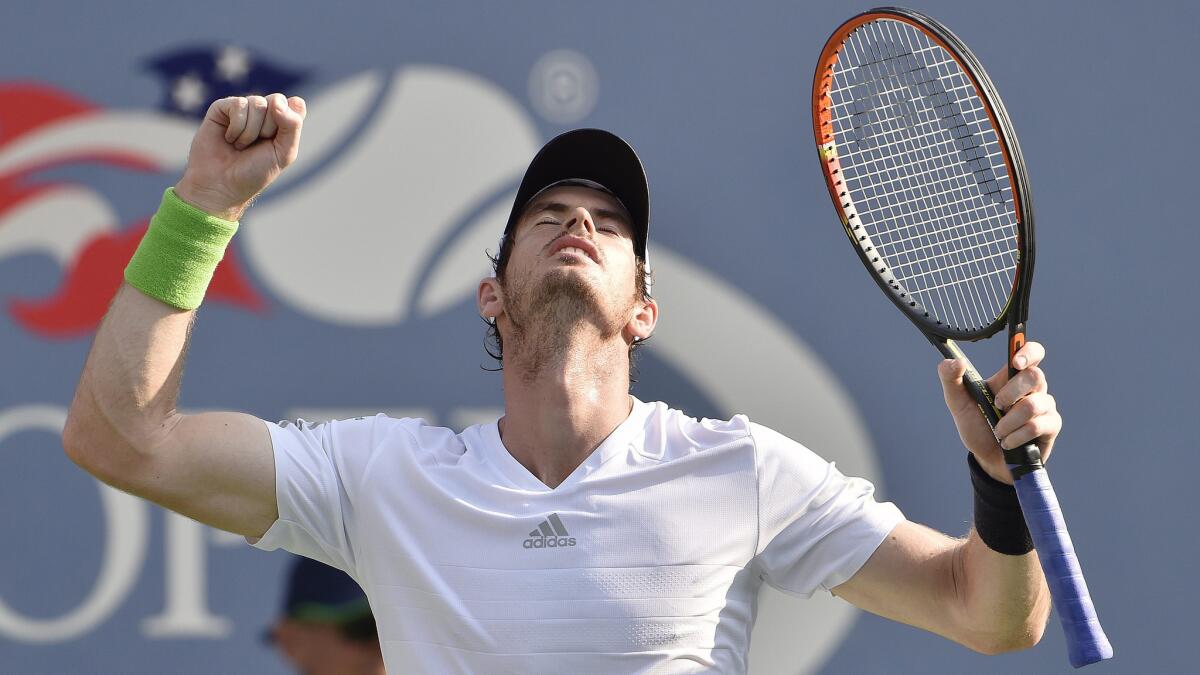Andy Murray looks more like himself in win over Jo-Wilfried Tsonga

- Share via
New York — In the heat and grind of the U.S. Open here Monday, Andy Murray took a step closer to being Andy Murray again.
He won a match that demanded a deep dig into his inner psyche. Giving his all, staying the course, gutting it out — all those coach-speak things that become cliches but actually matter —were required.
He did it against an opponent, Jo-Wilfried Tsonga of France, who will beat you while driving you crazy with his incredible talent and stunning flakiness. Or lose to you doing the same. Tsonga is like a genius who, more often than he should, will flunk a fifth-grade math test.
This drama played out on the main court, 22,500-seat Arthur Ashe Stadium. The match started in midafternoon with humidity measuring 86% and the place nearly packed, despite that. If you didn’t sweat, you weren’t alive.
To play a best-of-five-set match in this was a test of willpower. Or maybe sanity. On another court, 20-year-old women’s star Eugenie Bouchard needed her blood pressure taken and ice packs to keep her going.
She finished and lost. Murray finished and won.
The score was 7-5, 7-5, 6-4, and twice Murray came back from a service break down. Those breaks presented several opportunities to tank a set — yes, they do that — and wait for the sun to go down. Instead, Murray would look awful for a game or two, but rally back and fight hard and eventually hit the right shot at the right time or have Tsonga do something silly, like try a second-serve at 125 mph.
This huge effort may appear to be in vain. Next up for Murray will be a match against top-seeded Novak Djokovic, who won at Wimbledon and appears to be at the top of his game.
That Murray is even playing Djokovic as early as a quarterfinal speaks to what has been going on with the Brit. So does his No. 8 seeding here.
Once upon a time, not that long ago, he was a solid part of the Big Four of tennis — Djokovic, Roger Federer, Rafael Nadal and Murray. As recently as July, he was seeded No. 3 at Wimbledon, but the All England Club sort of twisted itself into a pretzel to justify that, even though there wasn’t a lot of outside complaining.
He was the defending champion, having given the Brits their first Wimbledon title in 77 years, so that had to count for something, they said. Plus, they factor in performance on grass. His performance had been that of a champion.
For Murray, it was tough to live up to all that.
He had won the U.S. Open in 2012, beating Djokovic in a rugged five sets. That was a few months after he had beaten Federer in the Olympic gold-medal final. It was the London Olympics. Tennis was held at Wimbledon. How could there be a higher high, other than the Wimbledon title itself, which he took care of the next year? One estimate had nearly 18 million Brits watching that 2013 Wimbledon final on TV.
A letdown after that should not be surprising.
He had back surgery near the end of last year, and you never come back from that as fast as sportswriters and fans project you will.
So he struggled, then changed coaches when Ivan Lendl, who had helped raise his game to the championship level, bowed out. To replace Lendl, Murray hired Amelie Mauresmo, the two-time Grand Slam champion from France. That was fine, except a certain level of British chauvinism prompted 50 carefully worded questions a day about the advisability of having a woman coach a man. Murray handled it well, but it just made it harder to focus on the actual tennis.
And then, after Murray breezed through the early rounds and raised expectations, along came the Grigor Dimitrov quarterfinal at Wimbledon. The handsome young Bulgarian made mincemeat out of Murray, who wandered about looking bewildered and left the devoted Brits in the stands on Centre Court in stunned silence.
From that loss, Murray slipped to No. 10 in the world, his lowest ranking since 2008.
All that lay ahead was the grind of the U.S. hard-court season, leading to the ultimate grind of them all, the U.S. Open.
For Murray, even that started badly. On Aug. 25, he played journeyman Robin Haase of the Netherlands and started cramping. He survived in four sets and says now, “I had just a terrible day.”
That brings us to Monday. Suddenly, there was lots of the old Murray. Big forehand winners, nicely constructed points, smart shots at key moments, lots of fight and mumbled curses at himself.
In his press conference, there were few hints of what he thought. He was asked the question in several different ways: After this performance, does he feel like he is back?
His answers were the usual noncommittal mumbles. He is bright, engaging and articulate when he wants to be. Monday, he didn’t want to be. He probably needed to be hydrated more than he needed to be answering questions.
But near the end, there was a glimmer.
“You know, playing on Wednesday, Wednesday night, against the No. 1 player in the world is exciting,” he said. “If you aren’t motivated or pumped up for those matches, then it’s time … to maybe stop.”
That was what Andy Murray would have said when he used to be Andy Murray.
More to Read
Go beyond the scoreboard
Get the latest on L.A.'s teams in the daily Sports Report newsletter.
You may occasionally receive promotional content from the Los Angeles Times.











